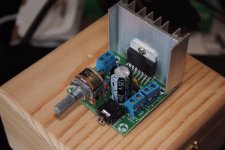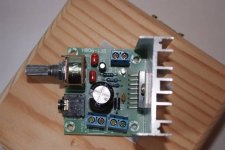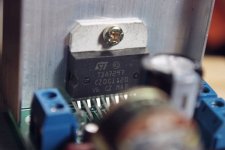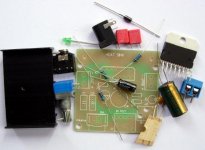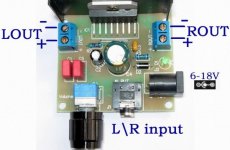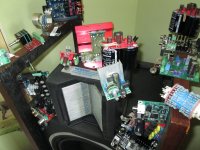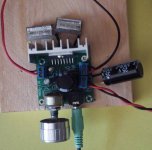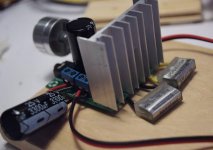Well since I did another PS board for the ta2020 I can just use that one as I'm not using the ta2020 amp for a while now. That PS board is set for 13.5VDC output. I need proper speakers :/
Feeding the amp 18vdc the heatsink remains at about room temperature driving my big 15 Ohm speakers. With a pair of 6 Ohm speakers the heatsink gets quite hot with a 12vdc ps, I'm guessing 4 Ohm speakers could be a problem.Yes, your TDA7297 could do dynamic peaks at 60 watts total system power, and the Class D chip will not be doing that. While driving your 4 ohm speakers, it might be more kindly to dial the power voltage down to 13.5vdc or less. With the TDA7297 chip, the actual voltage (that we should be using) could probably align like you're trying to Avoid activating the 2a limiter, except for very brief transient surges. However, 4 ohm speakers aren't mentioned in the datasheet so I don't know what the perfect operating voltage would be in that case. We do know that 16v is too high in this case. The 13.5vdc when driving 4 ohms, is really just a guess but it is in generally the right direction. 🙂
I have searched the internet to try to discover why speakers are being produced with 4 Ohm impedance but the answers are all over the place.
I'm guessing it has something to do with the marketing of amps and speakers back when power and power handling sold?
Feeding the amp 18vdc the heatsink remains at about room temperature driving my big 15 Ohm speakers. With a pair of 6 Ohm speakers the heatsink gets quite hot with a 12vdc ps, I'm guessing 4 Ohm speakers could be a problem.
I have searched the internet to try to discover why speakers are being produced with 4 Ohm impedance but the answers are all over the place.
I'm guessing it has something to do with the marketing of amps and speakers back when power and power handling sold?
Check out these 4 ohm speakers: MiniStatements
Those are good.
Several probabilities come to mind so it's not surprising there are multiple answers.
Last time I checked, copper was ~$2/lb. Half the wire length for the coil, 1/2 the cost, 1/2 the resistance.
If other things are factored in, probably end up being a wash. Larger diameter wire will have less resistance but you end up with a heavier coil which is more expensive for the same number of turns.
There's a couple of implications on cost for the passive components. You can still buy 2 Ohm automotive speakers and some car stereos recommend hooking 4 Ohm speakers up in parallel which results in ~2 Ohm load. If you only have 12 V to work with, you need a low resistance<reactance> speaker to flow enough current to produce qs volume.
Voltage and current both cost money with respect to semiconductors. That is at any given amperage as the voltage rating goes up, so does the price. Same hold true for hold voltage rating the same and up the amps. It would be a wash except all the other components like caps and diodes can be cheaper. Low voltage systems with low Ohm speakers should make it easier to hit a price point.
Last time I checked, copper was ~$2/lb. Half the wire length for the coil, 1/2 the cost, 1/2 the resistance.
If other things are factored in, probably end up being a wash. Larger diameter wire will have less resistance but you end up with a heavier coil which is more expensive for the same number of turns.
There's a couple of implications on cost for the passive components. You can still buy 2 Ohm automotive speakers and some car stereos recommend hooking 4 Ohm speakers up in parallel which results in ~2 Ohm load. If you only have 12 V to work with, you need a low resistance<reactance> speaker to flow enough current to produce qs volume.
Voltage and current both cost money with respect to semiconductors. That is at any given amperage as the voltage rating goes up, so does the price. Same hold true for hold voltage rating the same and up the amps. It would be a wash except all the other components like caps and diodes can be cheaper. Low voltage systems with low Ohm speakers should make it easier to hit a price point.
The validity of the double-woofer systems is not really questionable; however, the value of single woofer systems that have a harsh load in trade for only 2.5db more is a mystery.
I did make a two-way speaker of the Dayton RS180-4 and it was possible because it is a 4 ohm speaker; however, that was a hybrid-series (devore) crossover, quite the rare exception and I suppose, not the norm.
I did make a two-way speaker of the Dayton RS180-4 and it was possible because it is a 4 ohm speaker; however, that was a hybrid-series (devore) crossover, quite the rare exception and I suppose, not the norm.
Hello,
I'm somewhat late to the party, but reading this thread made me try this little amp - I got two of them from the usual source (ebay).
I already have a modded Sonic Impact T-Amp, and I like it - but it could definitely use some more "ooomph" 🙂
So, I thought I'd try this little bugger...
Got two of them a couple of days ago, and after several hours of listening, I must say I'm not really impressed.
Namely, I'm using stock amps, no mods yet (see attached photos).
The problem is that the sound is rather "flat", no real precision, separation or "3D" stage - unlike what I'm used to with my little T-Amp.
Also, it looks like the sound is distorted in some more dynamic passages, like piano (e.g. the piano intro in Tord Gustavsen Trio "Edges of Happiness" suddenly has harsh and distorted peaks), even though the pot is not on full power (about half, i.e. about 12 o'clock position).
I'm connecting it to Infinity SM85 speakers, very efficient and sensitive (98db), and feeding it from my Squeezebox Classic - the same setup I'm using with my T-Amp when comparing the two amps.
I'm powering the amp using the ordinary laptop "brick", 12V, 5A. I also tried swapping several other 12V "bricks" I have, but no real change...
Now, I presume that all of the above could be improved. Could it be the pot? It's OK otherwise, both channels are equal, no complaints there.
So, should I try the usual: first the pot, then the caps, if that does not help?
Or am I expecting too much? 🙂
I'm somewhat late to the party, but reading this thread made me try this little amp - I got two of them from the usual source (ebay).
I already have a modded Sonic Impact T-Amp, and I like it - but it could definitely use some more "ooomph" 🙂
So, I thought I'd try this little bugger...
Got two of them a couple of days ago, and after several hours of listening, I must say I'm not really impressed.
Namely, I'm using stock amps, no mods yet (see attached photos).
The problem is that the sound is rather "flat", no real precision, separation or "3D" stage - unlike what I'm used to with my little T-Amp.
Also, it looks like the sound is distorted in some more dynamic passages, like piano (e.g. the piano intro in Tord Gustavsen Trio "Edges of Happiness" suddenly has harsh and distorted peaks), even though the pot is not on full power (about half, i.e. about 12 o'clock position).
I'm connecting it to Infinity SM85 speakers, very efficient and sensitive (98db), and feeding it from my Squeezebox Classic - the same setup I'm using with my T-Amp when comparing the two amps.
I'm powering the amp using the ordinary laptop "brick", 12V, 5A. I also tried swapping several other 12V "bricks" I have, but no real change...
Now, I presume that all of the above could be improved. Could it be the pot? It's OK otherwise, both channels are equal, no complaints there.
So, should I try the usual: first the pot, then the caps, if that does not help?
Or am I expecting too much? 🙂
Attachments
Could even be that the parts are 'Fakes' ?
I don't know, the chips look legit enough...
As someone said earlier, I doubt they would fake the chips, they are cheap enough, although, who knows. There are even fake condensers on the market, so why not even fake cheap chips 🙂
I've taken a close-up of the chip on one of the amps - both have the same chip.. see pic...
Attachments
See enhancements at post 304. . .Got two of them a couple of days ago, and after several hours of listening, I must say I'm not really impressed. Namely, I'm using stock amps, no mods yet (see attached photos). The problem is that the sound is rather "flat", no real precision, separation or "3D" stage - unlike what I'm used to with my little T-Amp. Also, it looks like the sound is distorted in some more dynamic passages, like piano (e.g. the piano intro in Tord Gustavsen Trio "Edges of Happiness" suddenly has harsh and distorted peaks), even though the pot is not on full power (about half, i.e. about 12 o'clock position).
I'm connecting it to Infinity SM85 speakers, very efficient and sensitive (98db), and feeding it from my Squeezebox Classic - the same setup I'm using with my T-Amp when comparing the two amps. I'm powering the amp using the ordinary laptop "brick", 12V, 5A. I also tried swapping several other 12V "bricks" I have, but no real change...
Now, I presume that all of the above could be improved. Could it be the pot? It's OK otherwise, both channels are equal, no complaints there.
So, should I try the usual: first the pot, then the caps, if that does not help? Or am I expecting too much? 🙂
and 349
How do you manage a "3D" stage with 2 speakers? I can understand left right and possibly front to back, but what about up and down?Hello,
I'm somewhat late to the party, but reading this thread made me try this little amp - I got two of them from the usual source (ebay).
I already have a modded Sonic Impact T-Amp, and I like it - but it could definitely use some more "ooomph" 🙂
So, I thought I'd try this little bugger...
Got two of them a couple of days ago, and after several hours of listening, I must say I'm not really impressed.
Namely, I'm using stock amps, no mods yet (see attached photos).
The problem is that the sound is rather "flat", no real precision, separation or "3D" stage - unlike what I'm used to with my little T-Amp.
Also, it looks like the sound is distorted in some more dynamic passages, like piano (e.g. the piano intro in Tord Gustavsen Trio "Edges of Happiness" suddenly has harsh and distorted peaks), even though the pot is not on full power (about half, i.e. about 12 o'clock position).
I'm connecting it to Infinity SM85 speakers, very efficient and sensitive (98db), and feeding it from my Squeezebox Classic - the same setup I'm using with my T-Amp when comparing the two amps.
I'm powering the amp using the ordinary laptop "brick", 12V, 5A. I also tried swapping several other 12V "bricks" I have, but no real change...
Now, I presume that all of the above could be improved. Could it be the pot? It's OK otherwise, both channels are equal, no complaints there.
So, should I try the usual: first the pot, then the caps, if that does not help?
Or am I expecting too much? 🙂
How do you manage a "3D" stage with 2 speakers? I can understand left right and possibly front to back, but what about up and down?
Perhaps "3D" is not a "proper" term: I was thinking about the stage and the spatial perception of the instruments playing. Sometimes when I listen to my tiny T-Amp, it almost seems like I have a band/orchestra before me - the sound doesn't seem to come directly out of the speakers: it has a large sound stage and sometimes some of the sounds seem to come from unexpected directions, like slightly above or below the level of the speakers (or behind them) 🙂
Anyway, I've changed the pot, using a log 50 kOhm one I had at hand. After a few more hours of listening, the sound seems to have improved a bit.
However, louder listening still has some of that distortion I mentioned.
But, if I keep in mind how much I paid for these little amps, I really shouldn't complain 🙂
Hello,
I'm somewhat late to the party, but reading this thread made me try this little amp - I got two of them from the usual source (ebay).
I already have a modded Sonic Impact T-Amp, and I like it - but it could definitely use some more "ooomph" 🙂
So, I thought I'd try this little bugger...
.....Or am I expecting too much? 🙂
I have the exact board and also ordered two boards to start with. And I was going the exact path you were going (T-amp modding etc). But my result has been pretty much in-line with everyone else.
I found myself listen quite a bit to the 7297. I gave one 7297 board to a friend without any mod except eliminate the diode. The power supply for the friend was just a 12vac to bridge rectifier then c-r-c filter totaling about 6000 uF of capacitance. Nothing fancy but the result is great.
IMHO, I found class D amps seem to be critical with speakers matching. Class A/AB/chip etc seems to be a lot less critical with using different speakers. I believe it is because the inductance of the voice coil of the speaker is part of the output filter circuit in class D, whereas it isn't with a class A/AB amp.
...
IMHO, I found class D amps seem to be critical with speakers matching. Class A/AB/chip etc seems to be a lot less critical with using different speakers. I believe it is because the inductance of the voice coil of the speaker is part of the output filter circuit in class D, whereas it isn't with a class A/AB amp.
And the Class D output filter will perform differently depending on whether your speakers are really 16, 8, or 4 ohms through the filtering frequency.
Well, after a couple more days, I can say that the amp sounds OK.
But, I have another question: I bought two more as kits - the same kit as in post #231.
I soldered those, and both kits have a problem, namely, unlike the ready (assembled) amps, these exhibit a high-pitched "beep" when connected to input signal (Squeezebox classic). If it were just one, I'd attribute it to my poor soldering skills, but the other one was assembled (soldered) by a more experienced friend who's quite experienced with a soldering iron.
Could it be a design fault for this board?
Anything I could do to improve this and get rid of this "beep"?
Again, the two already soldered amps work as expected - no hiss, beeping or any other noise...
But, these two both produce high-pitched "beep" when the volume is turned up (e.g. to half volume...). I've tried different power sources - no change (except a slight change in pitch of the "beep"). The other two (already bought soldered) amps show no problems with the same power sources.
As a note, I've used the stock components that came with the kit, as seen in the attached photos.
But, I have another question: I bought two more as kits - the same kit as in post #231.
I soldered those, and both kits have a problem, namely, unlike the ready (assembled) amps, these exhibit a high-pitched "beep" when connected to input signal (Squeezebox classic). If it were just one, I'd attribute it to my poor soldering skills, but the other one was assembled (soldered) by a more experienced friend who's quite experienced with a soldering iron.
Could it be a design fault for this board?
Anything I could do to improve this and get rid of this "beep"?
Again, the two already soldered amps work as expected - no hiss, beeping or any other noise...
But, these two both produce high-pitched "beep" when the volume is turned up (e.g. to half volume...). I've tried different power sources - no change (except a slight change in pitch of the "beep"). The other two (already bought soldered) amps show no problems with the same power sources.
As a note, I've used the stock components that came with the kit, as seen in the attached photos.
Attachments
Sounds like feedback. You MUST route the output cables well away from the input ones. Could be fake chips I suppose 🙁
Sounds like feedback. You MUST route the output cables well away from the input ones. Could be fake chips I suppose 🙁
I don't know about fake chips - although the chips did look like they had a long and unhappy life which they spent in another device before I got them 😉
As for routing the cables, I'm using them in exactly the same way as the other (assembled) amps - and those do not exhibit this problem.
No big deal, I'll probably use these two for parts, but it bugs me... I'd like to know what's happening, and what's causing this high-pitched whine...
As a sidenote, the other two amps (which are OK) continue to surprise me, particularly with the bass response, which is quite good. I tried some other music besides my usuall jazz👍 tunes, and got quite a nice surprise with some lounge stuff, etc.
I also tried the Alan Parsons test CD, which someone mentioned earlier in this thread - and got quite a surprise when I distinctly heard the 31,5 Hz test tone coming from my speakers 🙂 Didin't even know they can go that low 🙂
Then I tried Yello's "The Race" from the same CD, and enjoyed it quite a bit 🙂 Nice bass line 🙂
Anyway, about my initial impression: that slight "buzzing/ringing" in some jazz piano tunes could be due to harmonic distortion or something, I don't know... But, apart from that, I'm quite happy with this amp... For less than $6, it's a steal 🙂 I think at least one of mine will get a nice enclosure.... maybe the same one currently occupied by my modded T-amp 😉
I think I'm about done with mods - tried several suggestions, some also from another forum (audiocircles)...
Anyway: removed the diode and bricked it, also completely removed the C2 little yellow capacitor - which resulted in definitive improvement of sound (no ringing any more in the upper registers!). In the attached photos I'm also trying out some RIFA 0.68uF caps that I had on hand - which resulted in some "fattening" of bass 🙂
Also, very important mod - adding a larger cap on the power input: I just soldered a 3300 uF cap on the "+" and "-" contacts of the power connector - which also improves bass. In short, as it is, it sounds quite nice - no complaints any more 🙂
I'd dare say it's quite comparable to my stock TDA3116 YJ 2.0 red board...
Oh, and changing the power supply for another "laptop brick" SMPS also improved the sound a bit (12V/4A)...
Anyway: removed the diode and bricked it, also completely removed the C2 little yellow capacitor - which resulted in definitive improvement of sound (no ringing any more in the upper registers!). In the attached photos I'm also trying out some RIFA 0.68uF caps that I had on hand - which resulted in some "fattening" of bass 🙂
Also, very important mod - adding a larger cap on the power input: I just soldered a 3300 uF cap on the "+" and "-" contacts of the power connector - which also improves bass. In short, as it is, it sounds quite nice - no complaints any more 🙂
I'd dare say it's quite comparable to my stock TDA3116 YJ 2.0 red board...
Oh, and changing the power supply for another "laptop brick" SMPS also improved the sound a bit (12V/4A)...
Attachments
anyone using this to power the amp?
- Home
- Amplifiers
- Chip Amps
- What the heck? It's less than lunch!
